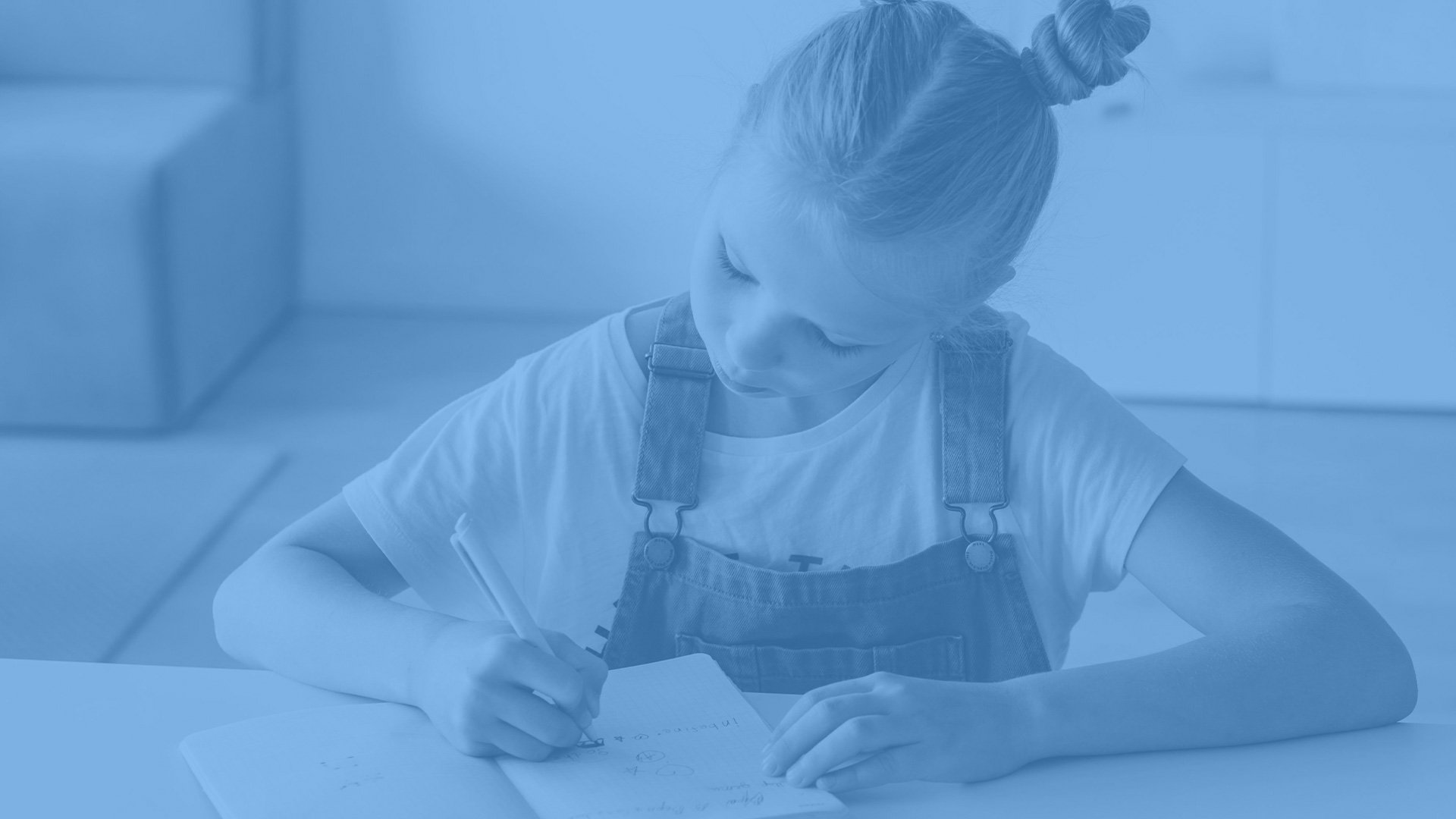
MathsBites is your go-to guide for
clarity, confidence and certainty.
MathsBites is based on the NSW syllabus, but it also aligns with every concept your child learns in the Australian Curriculum. Each topic is matched to its NSW equivalent and brought to life through engaging MathsBites videos.
Scroll through to explore everything your child will cover!
Unfortunately, this page is not very mobile friendly. For best results, please use a larger device.
Stage 2, Part A - Year 3
Whole numbers: Read, represent and order numbers to thousands
Group physical or virtual objects to show the structure of tens, hundreds and a thousand
Regroup numbers flexibly, recognising one thousand as 10 hundreds and one hundred as 10 tens or 100 ones
Compare and describe the relative size of numbers by positioning numbers on a number line
Count forwards and backwards by tens and hundreds on and off the decade
Represent numbers up to and including thousands using physical or virtual manipulatives, words, numerals, diagrams and digital displays
Read and order numbers of up to at least 4 digits
Identify the number before and after a number with an internal zero digit
Representing numbers using place value
Number
AC9M3N01
recognise, represent and order natural numbers using naming and writing conventions for numerals beyond 10 000
Whole numbers: Apply place value to partition and regroup numbers up to 4 digits
Record numbers using standard place value form
Partition numbers of up to 4 digits in non-standard forms
AC9M3N01
recognise, represent and order natural numbers using naming and writing conventions for numerals beyond 10 000
Additive relations
Use the principle of equality
Recognise equal differences and record them in number sentences
Use the equals sign to mean 'the same as', rather than to perform an operation
Apply the associative property of addition to forming multiples of 10
AC9M4N06 (Year 4 concept)
develop efficient strategies and use appropriate digital tools for solving problems involving addition and subtraction, and multiplication and division where there is no remainder
AC9M4A01 (Year 4 concept)
find unknown values in numerical equations involving addition and subtraction, using the properties of numbers and operations
Number
AC9M3N05
estimate the quantity of objects in collections and make estimates when solving problems to determine the reasonableness of calculations
AC9M3A01
recognise and explain the connection between addition and subtraction as inverse operations, apply to partition numbers and find unknown values in number sentences
AC9M4A01 (Year 4 concept)
find unknown values in numerical equations involving addition and subtraction, using the properties of numbers and operations
AC9M3A02
extend and apply knowledge of addition and subtraction facts to 20 to develop efficient mental strategies for computation with larger numbers without a calculator
Recognise and explain the connection between addition and subtraction
Use number relation principles to solve related problems
Demonstrate how addition and subtraction are inverse operations
Use the complement principle of addition and subtraction
Explain and check solutions to problems, including by using the inverse operation
Select strategies flexibly to solve addition and subtraction problems of up to 3 digits
Apply known mental strategies that use partitioning to add and subtract, such as bridging the decades
Use the compensation strategy to add and subtract
Apply the levelling and constant difference strategies
Represent solutions to addition and subtraction problems, including word problems, using an empty number line or bar model
Compare and evaluate strategies used to solve addition and subtraction problems, reasoning which strategy may be most efficient
AC9M3N03
add and subtract two- and three-digit numbers using place value to partition, rearrange and regroup numbers to assist in calculations without a calculator
AC9M3N06
use mathematical modelling to solve practical problems involving additive and multiplicative situations including financial contexts; formulate problems using number sentences and choose calculation strategies, using digital tools where appropriate; interpret and communicate solutions in terms of the situation
AC9M4N06 (Year 4 concept)
develop efficient strategies and use appropriate digital tools for solving problems involving addition and subtraction, and multiplication and division where there is no remainder
AC9M4N08 (Year 4 concept)
use mathematical modelling to solve practical problems involving additive and multiplicative situations including financial contexts; formulate the problems using number sentences and choose efficient calculation strategies, using digital tools where appropriate; interpret and communicate solutions in terms of the situation
Represent money values in multiple ways
Recognise the relationship between dollars and cents
Represent equivalent amounts of money using different denominations
Perform calculations with money, including finding change
AC9M4N08 (Year 4 concept)
use mathematical modelling to solve practical problems involving additive and multiplicative situations including financial contexts; formulate the problems using number sentences and choose efficient calculation strategies, using digital tools where appropriate; interpret and communicate solutions in terms of the situation
AC9M3M06
recognise the relationships between dollars and cents and represent money values in different ways
Generate and describe patterns
Model, describe and record patterns of multiples
Create and continue a variety of number patterns that increase or decrease by a constant amount
Recognise the significance of the final digit of a whole number in determining whether a given number is even or odd
Recognise the connection between even numbers and the multiplication facts for 2
Investigate the result of multiplying by one and zero
Multiplicative relations
AC9M3N06
use mathematical modelling to solve practical problems involving additive and multiplicative situations including financial contexts; formulate problems using number sentences and choose calculation strategies, using digital tools where appropriate; interpret and communicate solutions in terms of the situation
AC9M3N07
follow and create algorithms involving a sequence of steps and decisions to investigate numbers; describe any emerging patterns
AC9M4N02 (Year 4 concept)
explain and use the properties of odd and even numbers
AC9M4N08 (Year 4 concept)
use mathematical modelling to solve practical problems involving additive and multiplicative situations including financial contexts; formulate the problems using number sentences and choose efficient calculation strategies, using digital tools where appropriate; interpret and communicate solutions in terms of the situation
Number & Algebra
Use arrays to establish multiplication facts from multiples of 2 and 4, 5 and 10
Create and represent multiplicative structure, using the term multiples when connecting grouping to arrays
Use the array structure to coordinate the number of groups with the number in each group
Record the first 10 multiples formed by counting by twos, fours, fives and tens
Relate doubling to multiplication facts for multiples of 2
Recognise that doubling is multiplying by 2 and halving is dividing by 2
Recognise the relationship between one multiple and its double
Model square numbers and record in numerical and diagrammatic form
AC9M3N02
recognise and represent unit fractions including 1/2, 1/3, 1/4, 1/5 and 1/10 and their multiples in different ways; combine fractions with the same denominator to complete the whole
AC9M3N04
multiply and divide one- and two-digit numbers, representing problems using number sentences, diagrams and arrays, and using a variety of calculation strategies
AC9M3N07
follow and create algorithms involving a sequence of steps and decisions to investigate numbers; describe any emerging patterns
AC9M4N06 (Year 4 concept)
develop efficient strategies and use appropriate digital tools for solving problems involving addition and subtraction, and multiplication and division where there is no remainder
AC9M3N04
multiply and divide one- and two-digit numbers, representing problems using number sentences, diagrams and arrays, and using a variety of calculation strategies
AC9M3A03
recall and demonstrate proficiency with multiplication facts for facts for 3,4,5 and 10; extend and apply facts to develop the related division facts
AC9M4A02 (Year 4 concept)
recall and demonstrate proficiency with multiplication facts up to 10 x 10 and related division facts; extend and apply facts to develop efficient mental strategies for computation with larger numbers without a calculator
Recall multiplication facts of 2 and 4, 5 and 10 and related division facts
Recognise and use the symbols for multiplied by, divided by and equals
Link multiplication and division fact families using arrays
Generate multiplication fact families for multiples of 2 and 4, 5 and 10
Model and apply the commutative property of multiplication
Represent and solve problems involving multiplication fact families
Describe multiplication problems using for each and times as many
Find the total of partially covered arrays
Apply the inverse relationship of multiplication and division
AC9M3N04
multiply and divide one- and two-digit numbers, representing problems using number sentences, diagrams and arrays, and using a variety of calculation strategies
AC9M4N06 (Year 4 concept)
develop efficient strategies and use appropriate digital tools for solving problems involving addition and subtraction, and multiplication and division where there is no remainder
Partitioned fractions
Create fractional parts of a length using techniques other than repeated halving
Make thirds of a length
Create fifths of a length
AC9M3N02
recognise and represent unit fractions including 1/2, 1/3, 1/4, 1/5 and 1/10 and their multiples in different ways; combine fractions with the same denominator to complete the whole
Model and represent unit fractions, and their multiples, to a complete whole on a number line
Model fractions with fraction strips and diagrams for halves, quarters, eighths, thirds
Describe fraction families formed by dividing the whole into the same total number of equal parts as having the same denominator
Determine the complementary fractional part needed to complete one whole (halves, quarters, eighths, thirds)
Recreate the whole unit from a fractional part (halves, quarters, eighths, thirds)
AC9M3N02
recognise and represent unit fractions including 1/2, 1/3, 1/4, 1/5 and 1/10 and their multiples in different ways; combine fractions with the same denominator to complete the whole
Geometric Measure
Position: Interpret movement on a map
Orient a map to determine directions to travel
Use given directions to follow routes on land and Aboriginal maps without a grid reference system
Describe a route taken on a map using landmarks and directional language
Measurement & Space
AC9M3SP02
interpret and create two-dimensional representations of familiar environments, locating key landmarks and objects relative to each other
Position: Locate positions on grid maps
Locate positions by coordinating horizontal and vertical references
Use the array (row and column) structure of grid maps to locate position, horizontal before vertical
Length: Measure and compare objects using metres, centimetres and millimetres
Measure and record lengths and distances using a combination of metres and centimetres
Estimate lengths and distances using known lengths as benchmarks, in metres and centimetres and check by measuring
Compare and order lengths and distances using metres and centimetres
Recognise the need for a formal unit smaller than the centimetre to measure length
Identify that there are 10 millimetres in one centimetre
Use the millimetre as a unit to measure lengths with a ruler
Record lengths using the abbreviation for millimetres (mm)
AC9M3SP02
interpret and create two-dimensional representations of familiar environments, locating key landmarks and objects relative to each other
AC9M4M01 (Year 4 concept)
interpret unmarked and partial units when measuring and comparing attributes of length, mass, capacity, duration and temperature, using scaled and digital instruments and appropriate units
AC9M3M02
measure and compare objects using familiar metric units of length, mass and capacity, and instruments with labelled markings
Angles: Identify angles as measures of turn
Identify angles with 2 arms in practical situations
Identify the arms and vertex of an angle
Recognise an angle as the amount of turning between 2 arms
Compare angles and explain that the length of the arms does not affect the size of the angle
Use the term right angle to describe a quarter-turn in a range of orientations
AC9M3M05
identify angles as measures of turn and compare angles with right angles in everyday situations
2D shapes: Compare and describe features of two-dimensional shapes
Describe and compare two-dimensional shapes, including parallelograms, rectangles, rhombuses, squares, trapeziums and kites
Identify and describe polygons that have parallel sides and those that do not
Identify quadrilaterals that have all sides equal in length
Identify right angles in shapes
Group quadrilaterals using one or more attributes
Two-dimensional spatial structure
AC9M3M05
identify angles as measures of turn and compare angles with right angles in everyday situations
Space
2D shapes: Transform shapes by reflecting, translating and rotating
Identify lines of symmetry in pictures, artefacts, designs and the environment
Draw lines of symmetry on given shapes and identify quadrilaterals that do not have lines of symmetry
Create and record tessellating designs by reflecting, translating and rotating triangles
Apply and describe amounts of rotation including half-turns, quarter-turns and three-quarter-turns when creating designs
AC9M4SP03
recognise line and rotational symmetry of shapes and create symmetrical patterns and pictures, using dynamic geometric software where appropriate
Area: Use square centimetres to measure and estimate the areas of rectangles
Create the array structure of area using squares (1 cm × 1 cm) in rows and columns
Recognise that area can be measured in square centimetres
Discuss strategies to estimate area in square centimetres
Explain how the grid structure of rows and columns helps to find the area
Estimate and measure the areas of squares and rectangles (within the range of 100 square centimetres)
Record area in square centimetres using numerals and words
Use efficient strategies for counting large numbers of square centimetres
AC9M4M02 (Year 4 concept)
recognise ways of measuring and approximating the perimeter and area of shapes and enclosed spaces, using appropriate formal and informal units
Area: Use square metres to measure and estimate the areas of rectangles
Recognise the need for a formal unit larger than the square centimetre to measure area
Construct a square metre and use it to measure the areas of large squares and rectangles
Recognise that an area of one square metre need not be a square
Record areas in square metres using numerals and words
Estimate the areas of squares and rectangles in square metres
AC9M4M02 (Year 4 concept)
recognise ways of measuring and approximating the perimeter and area of shapes and enclosed spaces, using appropriate formal and informal units
3D objects: Make models of three-dimensional objects to compare and describe key features
Identify the differences between prisms (including cubes), pyramids and cylinders
Construct models of prisms, pyramids and cylinders using physical or virtual manipulatives, identifying their features
Deconstruct everyday packages that are prisms (including cubes) to create nets
Investigate the variety of nets that can be used to create a particular prism
Three-dimensional spatial structure
AC9M3SP01
make, compare and classify objects, identifying key features and explaining why these features make them suited to their uses
Measurement
Volume: Measure and order containers using litres
Recognise the need for formal units to measure capacity (internal volume) accurately
Use the litre as a unit to measure capacities (internal volumes) to the nearest litre
Relate the litre to familiar everyday containers
Recognise that one-litre containers can be a variety of shapes
Record capacities (internal volumes) using the abbreviation for litres (L)
Estimate the capacity (internal volume) of a container in litres and check by measuring
AC9M3M02
measure and compare objects using familiar metric units of length, mass and capacity, and instruments with labelled markings
Volume: Compare objects using familiar metric units of volume
Construct rectangular prisms using cubic-centimetre blocks and describe the volumes in terms of layers
Record volumes using numerals and words
Compare the volumes of 2 or more objects made from cubic-centimetre blocks
AC9M3M01
identify which metric units are used to measure everyday items; use measurements of familiar items and known units to make estimates
Mass: Compare objects using the kilogram
Recognise the need for a formal unit to measure mass
Identify familiar objects that have a mass of about one kilogram
Record masses using the abbreviation for kilograms (kg)
Find objects that have an estimated mass of more than, less than and about the same as one kilogram and check by comparing to a 1 kg mass
Non-spatial Measure
Measurement
AC9M3M01
identify which metric units are used to measure everyday items; use measurements of familiar items and known units to make estimates
Time: Represent and read analog time
Use minutes to describe the duration of events
Identify 30 minutes as being a half-hour and 60 minutes as an hour
Connect the quarter-hour to 15 minutes
Recognise that the position of the numerals on an analog timepiece often represents 2 different values
Recognise that 5-minute intervals (corresponding to the hour markers) are used as benchmarks to read time on an analog clock
Read time as past the hour to half-past and then towards the hour
Read analog clocks to the minute
AC9M3M03
recognise and use the relationship between formal units of time including days, hours, minutes and seconds to estimate and compare the duration of events
AC9M3M04
describe the relationship between the hours and minutes on analog and digital clocks, and read the time to the nearest minute
Collect discrete data
Pose questions about a matter of interest to obtain information that can be recorded in categories
Collect data from identified sources
Predict and create a list of categories for efficient data collection in relation to a matter of interest
Data
Statistics
AC9M3ST01
acquire data for categorical and discrete numerical variables to address a question of interest or purpose by observing, collecting and accessing data sets; record the data using appropriate methods including frequency tables and spreadsheets
Organise and display data using tables and graphs
Create a list or table to organise the data
Construct column graphs (with scale intervals of 1) and dot plots using relevant software where appropriate
Mark equal spaces (intervals) on axes, name and label axes and choose appropriate titles for column graphs
AC9M3ST01
acquire data for categorical and discrete numerical variables to address a question of interest or purpose by observing, collecting and accessing data sets; record the data using appropriate methods including frequency tables and spreadsheets
AC9M3ST02
create and compare different graphical representations of data sets including using software where appropriate; interpret the data in terms of the context
AC9M3ST02
create and compare different graphical representations of data sets including using software where appropriate; interpret the data in terms of the context
AC9M3ST03
conduct guided statistical investigations involving the collection, representation and interpretation of data for categorical and discrete numerical variables with respect to questions of interest
Interpret and compare data
Describe and interpret information presented in tally tables and column graphs
Investigate how data is interpreted to make decisions
Represent the same dataset using more than one type of display and compare the displays
Identify possible outcomes from chance experiments
Use the term outcome to describe any possible result of a chance experiment
Record all possible outcomes in a chance experiment where the outcomes are equally likely
Record all possible combinations in a chance situation where the outcomes are equally likely
Predict the number of times each outcome might occur in a chance experiment involving a set number of trials
Conduct experiments and compare the predicted and actual results where the outcomes are equally likely
Chance
Probability
AC9M3P01
identify practical activities and everyday events involving chance; describe possible outcomes and events as ‘likely’ or ‘unlikely’ and identify some events as ‘certain’ or ‘impossible’ explaining reasoning
AC9M3P02
conduct repeated chance experiments; identify and describe possible outcomes, record the results, recognise and discuss the variation
It’s a lot, right?
Don’t worry … MathsBites walks you through every single one, so that you are:
clear on exactly what your child is learning and how to help using the language and strategies they’ll use in class
ready to help them work with the maths concepts that are a part of their everyday lives
prepared, so when they get ‘stuck’, you can help them through
proactive rather than reactive.







